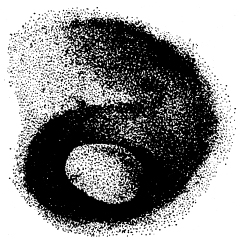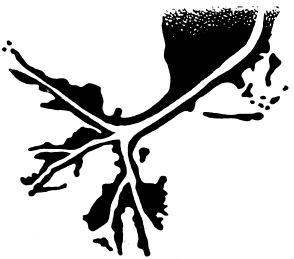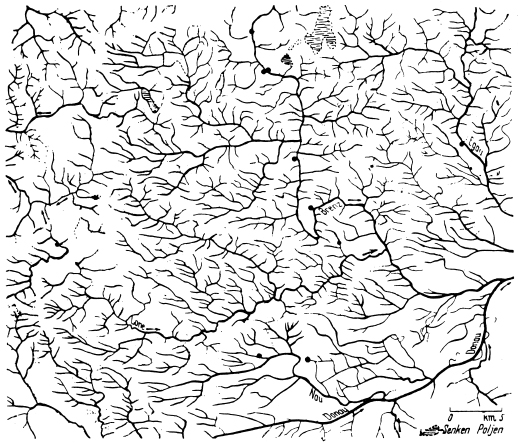
Water Interacting with the Earth
The forces of upthrust—we may also use the word ‘levity’ as opposed to gravity—represent a quality in water without which the life of the earth would be inconceivable. Water uniquely emphasizes this quality through its behaviour in relation to heat and cold. When frozen it becomes less subject to gravity, i.e. lighter, than when it is liquid. It is well known that ice floats on water. If this were not so, if ice were to become heavier than water and sink, then the oceans and all the water basins of the earth would gradually fill with ice from the bottom upwards and the earth would be transformed into a frozen waste. But by floating as ice, water once again reveals that it is its nature to serve life. Its density is greatest at a temperature of 4°C, i.e. above freezing point. At the temperature of 4°C. it is most concentrated, below and above this temperature it is less dense and therefore lighter per unit volume. Water that has seeped into the nooks and crannies of cliffs expands as it freezes, thus cracking the hardest rocks. In this way it starts off the dead, hard element on its way back to life. As through the action of water in the course of time the rocks crumble to a finer and finer consistency, they become the basis for plant growth and are again received into the great cycle of living nature. The same takes place each year in the fields, where the freezing of the earth and its organic components helps to prepare the fertile sod. This process is supported by the propensity of water to dissolve solid substances, to which, among other things, its great purifying property is due. Only through this ability to dissolve substances can it become a medium of transport for nutrients to and within organisms. We need only remember how apparently effortlessly water can dissolve a lump of sugar, which it would cost us a certain amount of effort to crack to pieces. On the other hand it is even possible for water to absorb gaseous substances, for instance carbon dioxide, whereby it increases its ability to attack what is solid. Under suitable conditions it can of course deposit the substances it has dissolved, creating such interesting formations as the sinter terraces in the Yellowstone National Park in North America (aragonite formations).
The dead rock is brought back to life not only through the ability of water to split it and to dissolve substances, but also through its mechanical properties, among which upthrust or buoyancy is one of the most important. The rock split off the mountain side rolls down the scree slopes and finally reaches the river where it loses some of its weight and is rolled on further. As though in a great mill the water smooths all its edges and corners, grinding it against other stones and rolling it onwards in potholes or along the bed of a stream, till it is finally reduced to pebbles or sand and the finest particles, which further downstream form the basis of fruitful arable land. The great culture of Ancient Egypt would have been inconceivable without this process. Religious rites accompanied the arrival of the Nile floods and the irrigation of the land, for every year the fertile mud—the foundation of the land between the deserts— was washed down anew.

The incurved forms of a water-worn pothole are caused by the grinding movement of stones driven round and round by water
Is it not characteristic of an element which everywhere serves life, that it rounds off sharp edges and all too solid forms, grinding them down and making them accessible to life? Indeed it even gives the stones in their shapes a similarity to living organs, creating here also spherical or elliptical forms. Particularly impressive are the stone balls in water-worn potholes, milling and grinding the hard rock into round and hollow forms (Plate 40).
All these processes take place simultaneously in rhythmical repetition. It is the rhythm that proves stronger than rigidity. Year in, year out, it splits the rocks, again and again the rubble is ground down by rhythmically recurring flood waters; every wave, every tiny trickle of water is rhythmically active in this crumbling process; century by century the stones roll rhythmically in the potholes, grinding the rock as in a great mortar. Every river bed resembles a series of these potholes, in which the river delves down into the hard subsoil. Shallows alternate with deep pools, which at times of flood are hollowed out more and more by the rolling stones and the might of the current. At the same time the river uses the detritus that it has ground up for itself for the construction of its river bed. It builds up its own boundaries, sorting out the coarser and finer detritus and setting it down in banks. It is an important quality of water that it has not only destructive forces, in the usual sense of the word, i.e. splitting and grinding forces, but that with the help of these forces it creates its own limitations, using them to build its banks or even to place obstacles in the way of its own torrent. It is very important to recognize this upbuilding quality of the water; it is its own compensation for its forces of destruction. Water destroys the hard rock and thus slowly brings it to life, but at the same time it tames its own surplus energy with what it has destroyed. The detritus and other materials, constantly on the move, are again and again deposited in the form of barriers and obstacles in the path of the rushing torrent. These obstacles are often found at fairly regular, rhythmical intervals. Deep reaches alternate with shallows where the speed of the current is checked. What it means to the whole aspect of the countryside when the water of a river is slowed down on its course, becomes obvious when compared with the opposite picture—canalization, of which the disastrous effects are well known.1
An impressive picture of the way in which a river builds its own barriers is offered by the Plitvice lakes in Croatia, where the calcium deposited by the water forms barriers across the current at regular intervals. In this way the river is slowed down and dammed up to form separate lakes.
The Mississippi delta in the Gulf of Mexico is an example of how a great river builds its own banks. The river deposits the fine material with which it is laden into the sea, piling it up till it reaches water level, thus extending the banks out into the sea. During the course of a long time the Mississippi has washed down so much firm ground that today cities stand where once there was nothing but the sea. In a river system such as this a prevailing unity is evident; the separate branches of the river all belong to a great organism. The Mississippi and its tributaries form a totality.

Mississippi Delta
Every river has its catchment area with tributaries, which in their turn have lesser tributaries and these again yet smaller ones. If the latter are traced to their source, they are found to disappear beyond their sources in a network of capillary veins that are often made visible by being filled out with a matted tangle of plant roots. This system of a river in its catchment basin is like a network of veins. Further downstream the main artery unites with a still greater one; for instance the Neckar flows into the Rhine, of which it is only a tributary. In this way all the different river systems unite to form one great network over the face of the earth, comparable to the network of veins in the human being. In man, too, the blood vessels of the separate organs unite to form a totality. The blood of the human being even builds its own ‘boundaries’, in the form of vessels, out of the blood corpuscles suspended in it.

Network of water veins in the catchment basin of the Brenz, a tributary of the upper Danube (after G. Wagner)
In the circulatory system of the human being, where every change or injury is noticed, the circulation as a whole accommodates itself to any disturbance; in a similar way the veins of the river system ‘perceive’ any change in the network, though this perception may not immediately become apparent to the human observer. The river system will eventually, for good or for evil, accommodate itself to any such change. A sad example of this is the ill-considered straightening of the upper reaches of a river, which can lead to severe flooding in the lower reaches. This can change the structure of a healthy river right down to its ground-water reserves and its subterranean capillary system. Not only are the lower reaches of the rivers affected by such alterations but also the land upstream. The fine network of water veins in the ground changes completely in the banks on both sides of a river that has been straightened and it digs deeper and deeper into the ground. Rivers thus deepened drain off the surrounding water, sucking it away from a wider and wider area, which is then in great danger of becoming arid.
Flowing water always attempts to form networks. This may be seen where the sea is shallow when the receding tide leaves deep veins in the sand (Plates 10, 17). Even in detail this network of channels in the sand reveals the curving meander-formation which, as we have seen, is one of the archetypal movements of water.
In the interaction of water with the solid earth, not only its dissolving and grinding activity must be taken into account, but also its ability to deposit and arrange substances. We have already mentioned this activity in connection with shingle and sandbanks, and in our description of the way it builds its own banks and creates such formations as the sinter terraces. This also is always a rhythmical activity. On a large scale it is evident in the barriers or deposits that water again and again places in its own path in rhythmical sequence; on a small scale it occurs in the repeated formation of ripple marks on the sandy beds of rivers or on the sea shore. The material deposited is constantly being rhythmically moulded and formed. Like the large barriers, these ridges, too, often lie across the current. Their form varies according to the depth and speed of the water and the kind of material being deposited. The play of forms in these ripple marks is very varied. Examples are given in Plates 8 and 12. Closer observation will show that these ridge formations are constantly changing, and slowly being pushed forward to make room for new material. Their progress is much slower than that of the water flowing over them; two different movements take place simultaneously. The more rapidly flowing water imprints a slower movement on to the material below it, forming it at the same time; whole landscapes in miniature, with gently sloping hills, ravines and so on, are carved in the soft material. Again and again curved and spiralling surfaces arise, like those with which we are already familiar. We are once more reminded of organic formative processes, according to which for instance the muscles in the higher animals and man are formed (Plate 18).
These formative processes in the water take place according to laws similar to those that prevail in the shaping of solid bones; vertebral and rib shapes are indeed ‘deposits’ of the liquid element. Some of the organic formative processes in man and animal may be found again in the movements of water—the ‘blood of the earth’— and the way it meets with the solid element (Plates 9, 18).
Rhythmical patterns of ridges also arise in stationary water, when ripples move over the surface. This occurs even in small dimensions if there is a sufficiently fine substance on the bottom, for example, a deposit of lime in the bottom of a jar.
To sum up: water flows and streams on the earth as ceaselessly as the stream of time itself. It is the fundamental melody that forever accompanies life in all its variations. Unremittingly it belabours the solid earth, grinding, milling, destroying, levelling out, and at the same time elsewhere building up again, creating anew, preparing for life. As the life blood of the earth, in the great network of veins, it shifts unbelievable amounts of substance, which everywhere accompany the life processes of the earth and its creatures. In a ceaseless process it transforms the hardest rocks and the highest mountains into a flowing, finely ground stream of substance, and it dissolves finished forms, preparing them for new creation. Water is thus the great exchanger and transformer of substances in everything that happens in metabolism. Constantly dissolving and solidifying, washing away and re-forming, in perpetual transformation, water is everlastingly creating the organism of the earth planet. Is it not as though the stream of time itself becomes visible to physical eyes in this perpetual activity of water? Water always proves stronger than anything too solidly anchored in space, continually leading it back into the stream of time, of living development.
In the passage of the earth round the sun, the stream of time is divided rhythmically into years and days, through the rhythm of the moon and the planets. So, too, the waters of the earth rhythmically work upon the material world.
The objection could be raised that all this happens quite automatically according to the fixed rules of cause and effect. But in these processes cause and effect so very often change places. In many processes in the realm of the liquid element the cause is in the same moment also effect and the effect at the same moment cause, whereby they unite in manifold interplay to form a moving totality. Just as in a living organism cause and effect intermingle in a simultaneous correlation, so do they also in water. For instance, the waves flowing over the beach arrange the sand in ridges, but at the same time these formations affect the waves and influence their forms. An interplay like this resembles an intimate co-operation that results in the creation of a third factor, which, however, can only be seen from a higher level, when the human mind apprehends the prevailing whole.
The creatures of nature can also only be understood from this higher level. They reveal its secrets. The wise, instinctive actions of the animals speak of the wisdom of nature creative in all the elements. Water checks its rapid torrent by placing barriers in its own path; it slows down its course and remains in a healthy relationship with the surrounding countryside. By flowing more slowly it prevents the fruitful earth from being washed out to sea and gives it back to the land by depositing it again. A creature such as the beaver is like an embodiment of all this wisdom. In all its actions it joins in with the propensity of water to regulate its own flow, thus increasing the fruitfulness of the land. The beaver brings this activity of the water to still greater perfection; by constructing dams it slows down the flow of the water and regulates it. Its instinctive actions are so bound up in what is happening between water and the countryside that it forestalls a flood by raising its dams, thus preventing destruction. For instance, the renowned fertility of the earth of the Mississippi basin is considered to be the result of the activities of beavers over thousands of years, who by damming the river slowed it down, thus causing the fertile mud to be deposited. The desperate efforts to reintroduce beavers to the upper reaches of the river, where they have been exterminated, testifies to the importance that today is once again being attached to them. They are an important counter measure to the straightening of the rivers and streams by which inconceivable amounts of the most fertile soil are annually washed down into the sea.
1 This does not exclude the fact that it may be necessary in moderation to correct the course of a river and incorporate it into the cultivated countryside.